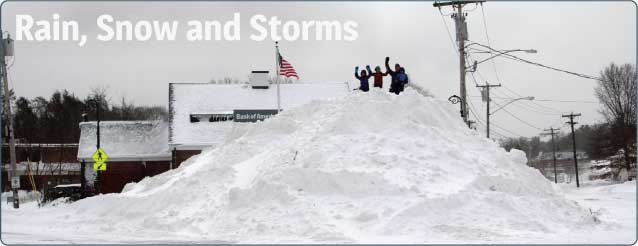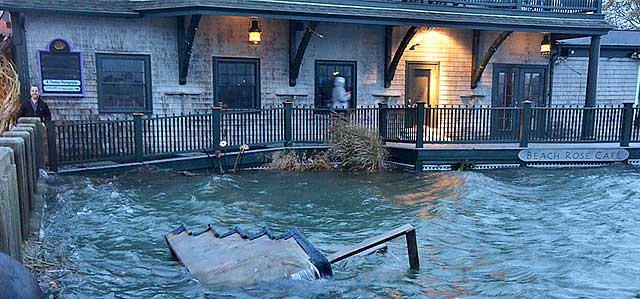
Photo Credit: O. Van Dyke
Rain, Snow and Storms: Coming on Strong
“If you don’t like the weather in New England now, just wait a few minutes.”
- Mark Twain
A very important point for debates at either the café or conference table: climate change does not necessarily mean more storms; it means more severe storms are likely coming our way in New England.
Locals in Rhode Island got a taste of that in the winter and early spring of 2010. Blizzards that had people’s backs aching for weeks after they shoveled out of waist-high snowdrifts followed by nor’easter rains that flooded nearly the entire state (“of Biblical proportions” became a highly popular phrase in the media), left basements full of water, washed out the area’s largest shopping center for months along with several bridges, and closed Route 95 — the carotid artery in the heart of the state.
Unfortunately, we had better get used to it.
The Facts
It isn’t just Rhode Island that is experiencing an increase in storm intensity. Globally, the severity of tropical cyclones (aka hurricanes and typhoons) has increased since the 1970s, and in the U.S. Northeast, the severity of tropical cyclones in the North Atlantic has also picked up significantly.
- The substantial increase in the severity of global tropical cyclones since the 1970s has been found to have a strong link to the observed increase in ocean surface temperatures. And the temperature of the waters off the southern New England coast has increased by 2.2°F. What we do know is that the North Atlantic storm intensity correlates well with variations in tropical Atlantic sea surface temperature.
- Major storm tracks have been moving northward. This has been scientifically attributed to changing climate.
- Some studies have reported an increase in the number of tropical cyclones in certain areas, including the North Atlantic.
Changing Characteristics
Whether the characteristics of tropical cyclones have changed has been the subject of considerable investigation, often with conflicting results. Therefore, it remains uncertain whether past changes in tropical cyclone activity have exceeded the variability expected from natural causes. In other words, we expect some range of change in severity but are we way past the boundaries of change that are normal and expected? There’s that word again: uncertainty. Let’s understand that in scientific circles, uncertainty is synonymous with honesty. And we are betting that people would prefer honesty even in the face of a measure of uncertainty. We often have times when we act without absolute certainty. Crime in your neighborhood? Maybe you get a dog even if there is no guarantee that you will be a target. E-coli in salads? Well, maybe you’ll order a sandwich even if it blows your diet to bits. And let’s not even talk about lottery tickets. The truth is that we work with uncertainty every day that is less statistically convincing than the impacts of climate change and yet many of us choose to reject it due to uncertainty. Scientists are trained to reveal any level of uncertainty. Even gravity is considered a theory. But is anybody walking off a cliff based on that theory?

Photo Credit: RI Sea Grant
Hurricanes
Climate change may affect tropical cyclone intensity, frequency, track, size, and/or rainfall. Hurricanes require warm sea surface temperatures to develop and to be maintained. As the global climate warms, the sea surface temperature also increases in the tropical oceans where hurricanes form. In theory, hurricanes may then become more intense or better able to survive at a high intensity for longer periods of time. Projections consistently indicate that oceanic warming will cause the globally averaged intensity of tropical cyclones to shift towards stronger storms, with intensity increases of 2 to 11 percent by the end of the century. Existing modeling studies also consistently project decreases in the globally averaged frequency of hurricanes by 6 to 34 percent. Balanced against this, higher-resolution modeling studies typically project substantial increases in the frequency of the most intense cyclones, and increases of 20 percent in the precipitation rate within 60 miles of the storm center. There have been estimates of about a 30 percent increase in potential damage from the combined effect of fewer hurricanes overall and more very intense hurricanes.
See the Hurricanes page for a look at storms that have made landfall in New England.
What About Rhode Island?
Rhode Island has been impacted by a number of major storms and they represent a significant coastal and marine hazard, resulting in loss of life, property, aesthetics and the very sense of place we all define as our home. Storms and associated storm surges can cause damage to ports, seawalls and revetments, docks, roads, bridges, wastewater treatment plants and stormwater infrastructure. Storms can also damage wind turbines and other offshore infrastructure, and affect sediment movement, altering beaches and coastal habitats, as well as impacting marine transportation and port operations. Potential damage from increasing storm intensity to infrastructure, property and life is a matter of record. In terms of wave height and storm surge, the Hurricane of 1938 was the magnitude of a 100-year storm for Rhode Island. This means that there is a 1 percent probability of a storm of that size occurring in any single year. However, with more intense storms, the probability increases that any one storm will be greater than one currently defined as a 100-year storm.
“For months we have had scarcely any rain... The grass and the trees have seemed to remain at a standstill, as though waiting for something. When I pour waterpot after waterpot of water about the roots of some favorite or needy plant, the water runs off the caked ground... seemingly, without quenching the fever-thirst of the earth.... [T]he beauty of rain is a thing often missed, I think, even by those who do keep, as they pass through this world, a keen eye for the Creator’s thoughts, embodied in beauty about them...”
- John Richard Vernon, The Beauty of Rain, 1863
“What has happened down here is the wind have changed/ Clouds roll in from the north and it started to rain/ Rained real hard and rained for a real long time/ Six feet of water in the streets of Evangeline/ The river rose all day/ The river rose all night/ Some people got lost in the flood/ Some people got away alright/ The river have busted through clear through down to Plaquemines/ Six feet of water in the streets of Evangeline”
- Randy Newman, Louisiana 1927
News
Factoids
Precipitation
In Rhode Island, precipitation has increased by over 12 inches since 1905, mostly during non-summer months.
By 2100, precipitation in New England during non-summer months may increase by an additional 7-14% above the current average, leading to a higher risk of flooding.
Extreme Precipitation and Hurricanes
The frequency of extreme precipitation events is projected to increase. A storm that now has a 5% chance of happening in any year may have a 20% chance of happening in the future.
Increased activity of extra-tropical storms (Nor’easters) on top of an already higher sea level will increase coastal flooding and erosion.
While the number of hurricanes is not expected to increase, an increase in the intensity of hurricanes in the Atlantic Ocean is expected.
In some areas of the Northeast, storm surges associated with future hurricanes could be 2 to 4 feet higher than present conditions.




